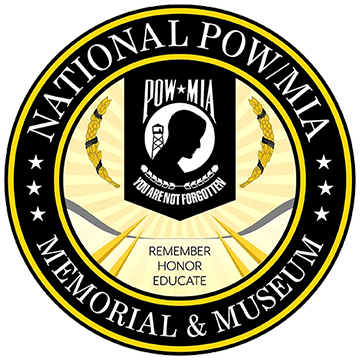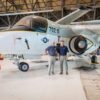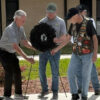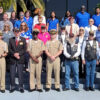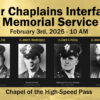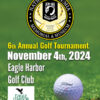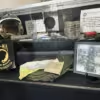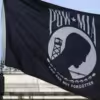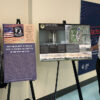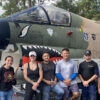by Buddy Harris – Spokesperson
It has been a long and arduous journey, but aircraft have finally landed and assumed their final guard duty as protectors of the National POW/MIA Memorial and Museum, and all who enter.
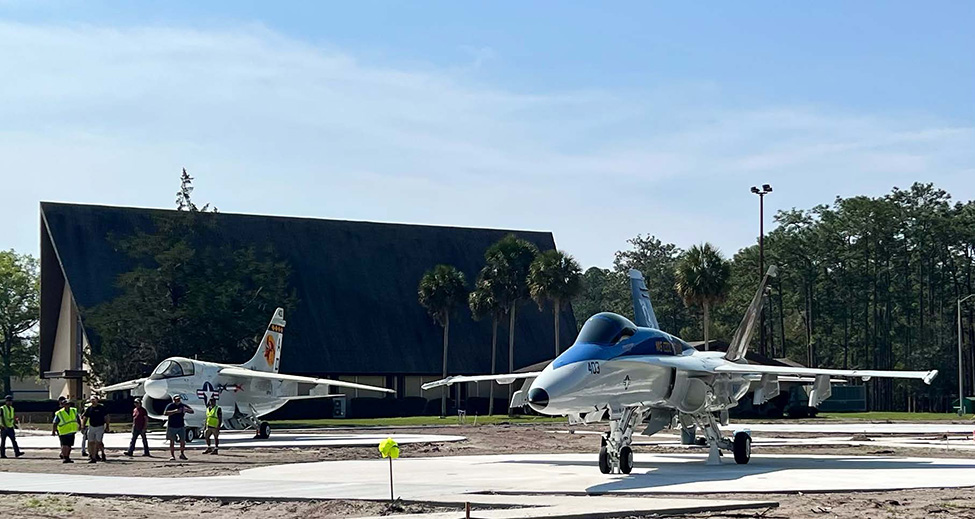
They will eventually be joined by an S-3 Viking and A-4 Skyhawk, but for now, the F/A-18A Hornet and the A-7A Corsair II will hold down the fort. They are certainly up for the challenge, as they are no strangers to adversity. The last few years have been very challenging for the National POW/MIA Memorial and Museum, just as they have for the rest of the world. Covid 19 affected us greatly, but we will not be deterred. This Memorial is vital for this nation to remember, contemplate, and pay tribute to our American Prisoners of War and those Missing in Action. There have been approximately 140,000 POW’s since World War II, and still over 80,000 still classified as MIA. It is imperative that we have a place to not only honor and pay respect to these service members representing all branches of the United States Military, but a place where their families, loved ones and the civilian population in general can find comfort and reflect. This is our mission, we will not fail.
Phase I is the part of the National POW/MIA Memorial and Museum dedicated to the POW’s and MIA’s based at the former
Master Jet Base Cecil Field, which contained the only MIA Memorial in the United States. This includes renovating the
Chapel of the High Speed Pass, displaying the runways and main aircraft based at NAS Cecil Field, as well as the history of
the USS Saratoga and the USS Forrestal. We knew that things would progress significantly once we were able to get our aircraft on display. We just had no idea when that special day would get here, or how we would even accomplish the considerable task.
Our A-7A Corsair II BuNo 153150 arrived from Pocahontas, Arkansas in September 2019. The aircraft was in disrepair when it was found, and then the wings and tail had to be cut off for transportation. To say it was a project was a tremendous understatement. We needed help, a lot of help. First being a place to store our aircraft, as we began the process of putting her back together. We knew this was going to be an extremely difficult operation, and might take awhile. First to step up was Scott “Huey” Morrison of Million Air Jacksonville-Cecil Field. He has long been a tremendous supporter of the Memorial, and helped us out significantly, not only with storage of the A-7, but transportation, knowledge and support as well. He has been, and will continue to be, invaluable.
As I was researching the engineering and refurbishing requirements of our little beauty, I stumbled across our first guardian angel. During my pitch to Flightstar, an FAA Part 145 Repair station at Cecil Airport, I met Max Miroshin, a manager at the main repair facility, who quickly became emotionally involved in our project. Covid 19 had just hit the aviation world hard, and Flightstar had a lot of repair cancellations. He fought and got approval to bring in the A-7 and give her life, as well as provide training in aircraft engineering, preparation and painting. Without Max Miroshin and Flightstar, I am not sure how we could have completed the task.
When it came time to determine which squadron or logo should be used, we certainly had no shortage of inputs. Instead of determining which squadron had the most POW’s or MIA’s, we decided that the A-7 began at Cecil Field with VA-174, the RAG(Replacement Air Group), and most east coast A-7 pilots went through there at some point. That is where those we honor began, this is where we begin. And if we are going to start at the beginning, we needed the original logo that Walt Disney Studios designed for VA-174. The logo had changed over the years, and due to costs, was removed from the aircraft entirely in the 70’s, although it remained on the squadron patch. Flightstar painters were able to recreate the logo on the tail, as well as the diamonds and “AD” designation. It is exactly as envisioned.
Who we honor on the aircraft was the next project. We wanted to put a former POW on one side and a designated MIA on the other. It was decided that local CAPT Dale “Roadrunner” Raebel with 225 days in captivity earned one side, and CDR
Fred “Fled” Wright earned the other. We decided to put the names on in cursive because that was a common method during the Vietnam War. BuNo 153150 was ready for her coming out.
Unfortunately, also due to Covid, the preparations for the aircraft display site had come to a halt. We had nowhere to go, but we needed to get the aircraft out of the Flightstar hanger. They were back in business, and needed the room. We decided to temporarily display the A-7 in the National POW/MIA Memorial and Museum parking lot. It wasn’t ideal, but it would have to do. And then someone questioned how we were going to get the A-7 over to the Memorial. There is a security fence around the perimeter, and we had to get past it somehow.
When Cecil Field was a Master Jet Base, there was a large gate for all aircraft to access. Since it became privatized, things have changed and now the largest gate is 30’ in width. Since the A-7 has a wingspan of 38’9”, we had a problem. Due to the mechanical and security situations with the fence, even a temporary displacement was unmanageable. This is when Crane and Rigging of Jacksonville stepped up. It was decided that with their crane, they could, with extra padded straps, lift the A-7 up and over the gate with the least obstructions. It was going to be complicated, innovative, and daring. It worked to perfection. I stated at the time that this would be the last time an A-7 took off and landed at Cecil Field. As it turns out, I would be proven wrong.
The F/A-18A BuNo 162462 was on display in front of JAA Operations at Cecil Field. Prior to that it had been on guard at
the main gate of Cecil Field. When Cecil Field closed as a Master Jet Base, the Hornet was moved to JAA Operations. The
aircraft was dedicated to Navy Captain Scott Speicher, the first pilot shot down in Desert Storm, whose status went from
KIABNR (Killed in Action, Body Not Recovered), to MIA (Missing in Action), then POW (Prisoner of War) before his final status of KIA(Killed in Action). Navy personnel from VP-16, a P8 squadron based at NAS Jacksonville, volunteered to paint the aircraft in honor of Capt Speicher, as his son was their Intelligence Officer. After many years out in the elements, unfortunately the aircraft fell into disrepair.
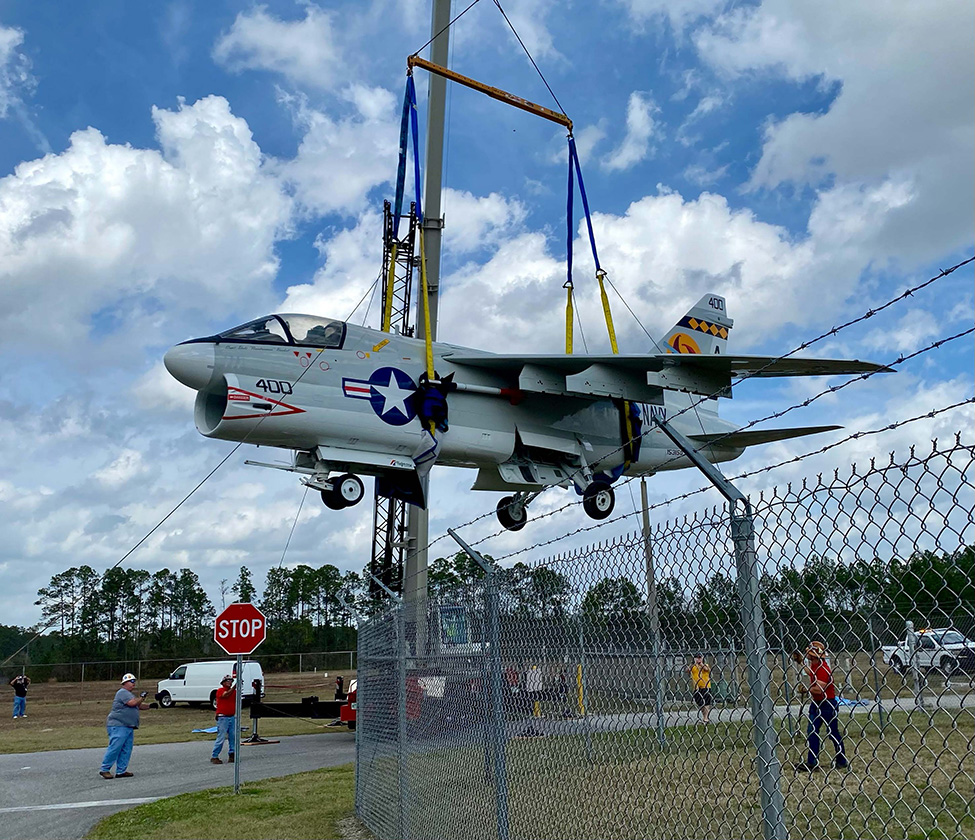
Due to the extensive maintenance and cost, JAA decided to transfer ownership of the Hornet to the Memorial under two conditions. First, that it keeps the Speicher name, and second, that we don’t move it until have found a proper place for refurbishment. Of course we agreed with both stipulations.
The first was our immense honor, the second we knew was going to be a formidable challenge. Flightstar was booked solid, and our options were very limited. That is when my next guardian angel stepped forward. We felt that Boeing could be a good match, having a large presence at Cecil Airport and doing all the Hornet rework, but we were not getting a lot of traction.
At the unveiling of the A-7 in the Memorial’s parking lot, Dan “Dano” Mastrolia, who works at Boeing, stepped forward and said he felt strongly his Boeing guys could do a better job with the Hornet than how the A-7 turned out. Challenge thrown, challenge accepted. So Dano started pushing from his end, and we started pushing from the top with some very senior old Hornet pilots. It took a few months, but it all came together with a lot of help from Boeing’s Bill Maxwell. It was decided Boeing would like to partner with the Memorial, and make this happen. Boeing provided the space, work products and tools, and Dano provided the numerous volunteers. It was a perfect marriage.
Of course the Boeing hanger is located inside the flight line, and the Hornet was not. Familiar territory. So I called Crane and Rigging of Jacksonville, and despite the Hornet providing a different set of problems, Jeff Schmidt came out and said, “we got this.” Jeff being an old Navy Seabee, was used to sorting unusual problems and making it work. So he brought a crew out and made it work. He also said when we are done, let him know and he will bring it back for the Memorial. I run into so many great Patriots!
The Hornet was not easy project. It had a lot of corrosion and a few missing parts. It took a few months to prep out, but we had it ready and Dano found a couple of very experienced painters in Iran “Smitty” Smith and Ryan Kelly. We also needed some high quality aviation paint and even better clear coat. Boeing was unable to supply the paint due to government regulations, so I went back to my A-7 expert, Max Miroshin, and asked for advice. As it turns out, he had changed jobs and now works for Mankiewicz Coatings, and they specialize in high quality aviation paint. He connected me with his boss Phong Lai, who loved what we were doing and had family in the military, so he took great care of us. The products were tremendous.
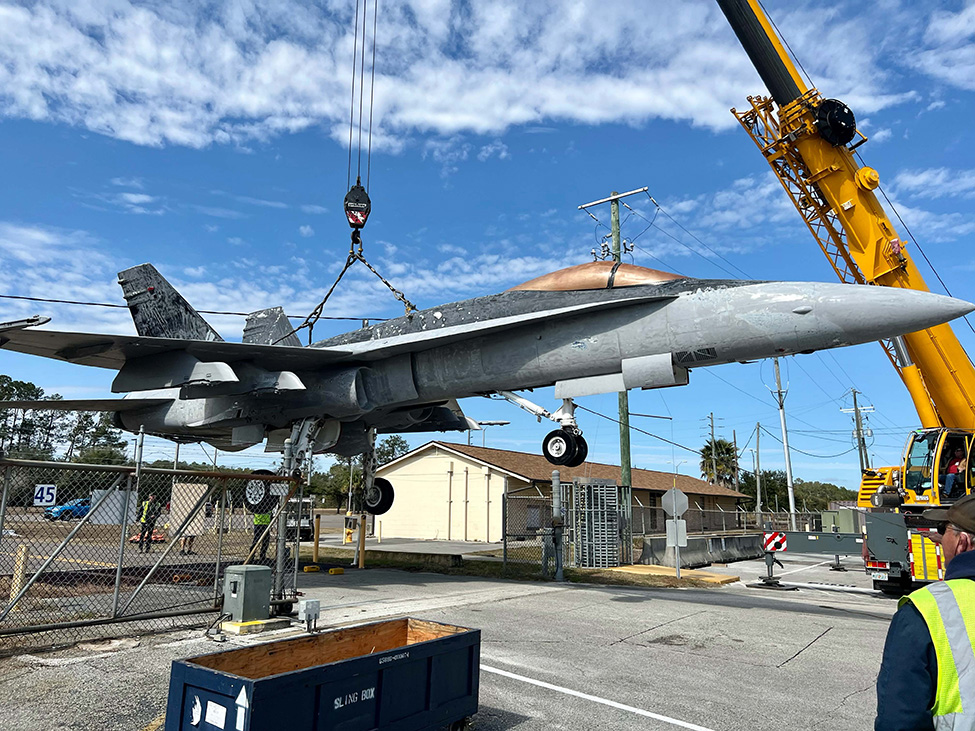
Of course, just as we finished the preparation process, and had the Hornet ready for paint, Ryan got reassigned and was unable to meet on weekends when we worked. Thus Smitty ended up painting almost the entire aircraft himself, with Dano and I pretty much just getting in the way. But make no mistake, Dano was in charge.
As for the design on the Hornet, we decided to use the logo for VFA-106, again the first Hornet squadron, and the RAG, as we attempted to honor all the Hornet pilots from Cecil Field. We actually created and used the logo from their patch, as this is a one of a kind, and significantly more exciting. We were truly honored to keep the CAPT Scott ”Spike” Speicher name, as promised, as well as the number 403 and the USS Saratoga, as this was the last aircraft number and ship from which he flew. We also wanted to honor Cecil Field with the years it existed, and Blue Angels color scheme to honor their beginnings in Jacksonville. We are very proud with the results. I cannot thank Dano, Smitty and the rest of the Boeing guys enough. Now we had two completed jets, but nowhere to place them. The concrete display pads beside the Chapel of the High Speed Pass had yet to be completed, and it was all way behind schedule. We needed a spot now for the Hornet, because Boeing needed the hanger, and the parking lot was not an option. Once again Scott Morrison came to the rescue and found a spot for us on Jetport property. The fact that we had no idea when the pads would be completed, it was an incredible offer.
After a lot of back and forth, we finally came up with February 25 to move the jets. It was originally planned that Jeff with
Crane and Rigging would lift the Hornet over the gate and we would then taxi both jets to the pads, but this became a lot more complicated. It was determined that the grounds were not prepared correctly for that, and we would now need Jeff and his crew to lift the Hornet over the gate, and then reposition the crane to the Memorial so they can then lift the respective jets onto their permanent pads. Oh, and to add a little more degree of difficulty, both aircraft need to be placed on stands. I looked at Jeff and he again said “no problem, we got it.“ He brought his best driver, Kenny Gisendorf, and they did not disappoint.
The first important factor was weather, and it could not have been better. Sunny with very little wind. There were a lot of folks involved in the movement, and everything had to work perfectly for success. Everyone got there early, and Dano was running the show, with Keith Shea filling in for Smitty. Getting the Hornet back over the gate went flawlessly. We had plenty of help from Boeing, Million Air, JAA and the Memorial.
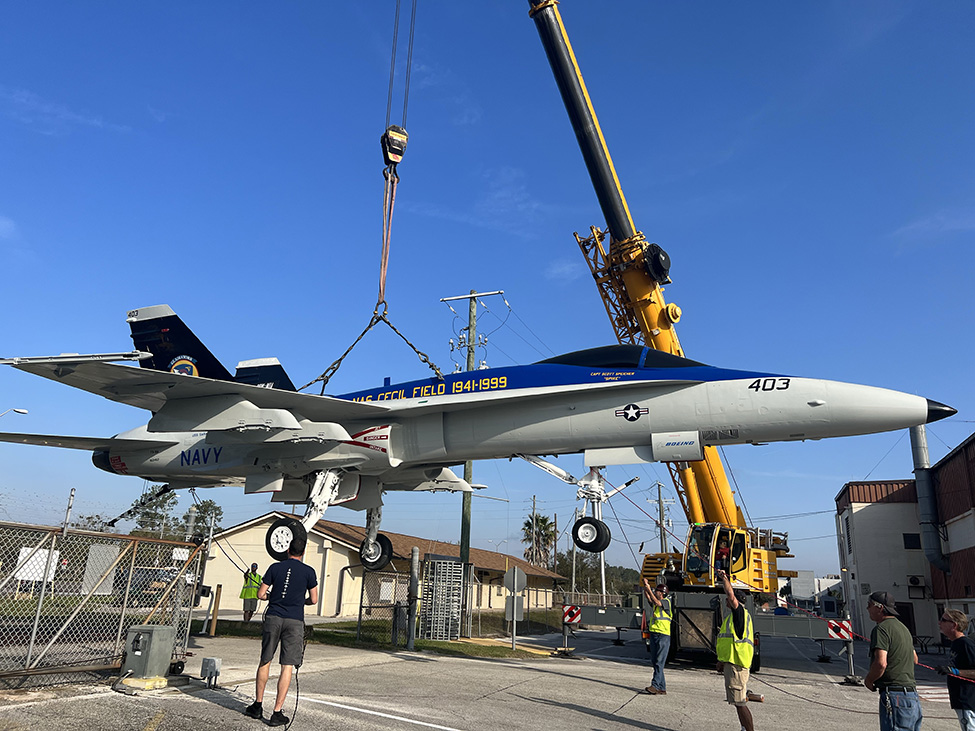
We had numerous obstacles to avoid taxiing the jet to the Memorial, but with Brian Corfman on the tug, it was a piece of
cake. Once arriving at the Memorial, it was Jeff and the Crane and Rigging of Jacksonville’s show. The Hornet was placed first, as it was the easiest and closest, with larger stands on which to place.
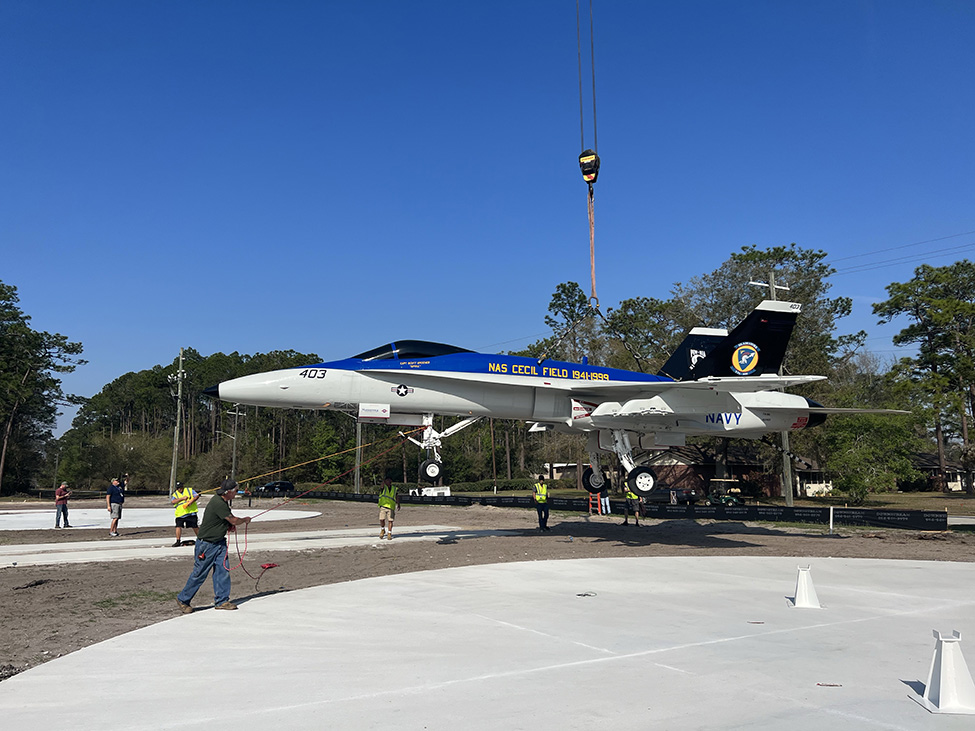
The A-7 was considerably more difficult, as the crane had to be moved to a less stable position, and it was a farther reach. Also, the stands were more exacting, as they were uniquely handmade by Jason Farnsworth to fit the A-7 jack points. Placement had to be precise. Kenny drove the crane perfectly, as the A-7 settled in, and the stands, as well as the aircraft looked incredible. And now we finally have the last time an A-7 and F/A-18A have taken off and landed at Cecil Field.
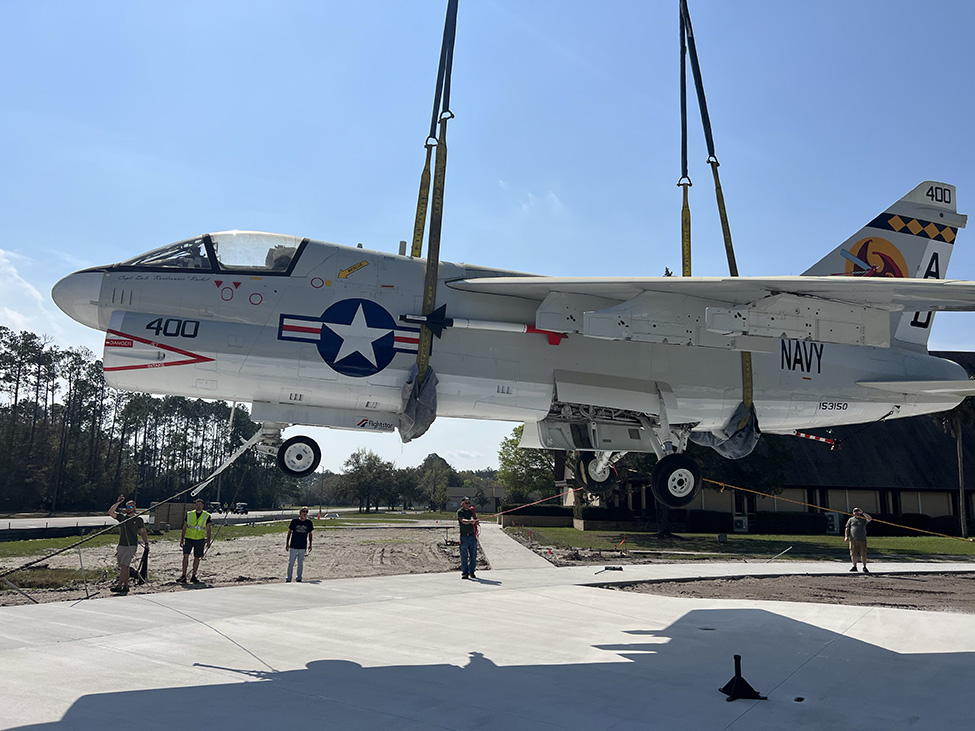
February 25th was a tremendous day, all brought together by some incredible Patriots. It was a huge step for the National POW/MIA Memorial and Museum, as we attempt to close out Phase I. It was a very difficult and challenging 3 1/2 years in the making, but the phenomenal results were well worth the considerable plight. Without the help, knowledge, sacrifice and dedication of all those mentioned, as well as numerous others, this would have never come to fruition. We prevailed.
We now have a new sense of moving forward, and have provided two extraordinary reasons for others to stop and take notice. And I know the two are both glad to be in their permanent posts. It was a long journey for both, with the A-7 doing two tours in Vietnam before finding its way to Cecil Field, and the Hornet traveling the world. Both spent many years on the front lines of keeping this nation free, and brought many pilots home to their loved ones. When you go to visit, and admire how beautiful they look, now protecting the National POW/MIA Memorial and Museum, think about all they went through to get here, and hopefully the first thing that comes to your mind is, “Thank you for your service”.

